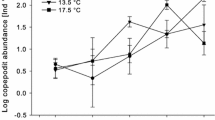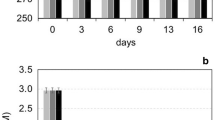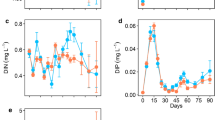Abstract
Shifts in the timing and magnitude of the spring plankton bloom in response to climate change have been observed across a wide range of aquatic systems. We used meta-analysis to investigate phenological responses of marine and freshwater plankton communities in mesocosms subjected to experimental manipulations of temperature and light intensity. Systems differed with respect to the dominant mesozooplankton (copepods in seawater and daphnids in freshwater). Higher water temperatures advanced the bloom timing of most functional plankton groups in both marine and freshwater systems. In contrast to timing, responses of bloom magnitudes were more variable among taxa and systems and were influenced by light intensity and trophic interactions. Increased light levels increased the magnitude of the spring peaks of most phytoplankton taxa and of total phytoplankton biomass. Intensified size-selective grazing of copepods in warming scenarios affected phytoplankton size structure and lowered intermediate (20–200 μm)-sized phytoplankton in marine systems. In contrast, plankton peak magnitudes in freshwater systems were unaffected by temperature, but decreased at lower light intensities, suggesting that filter feeding daphnids are sensitive to changes in algal carrying capacity as mediated by light supply. Our analysis confirms the general shift toward earlier blooms at increased temperature in both marine and freshwater systems and supports predictions that effects of climate change on plankton production will vary among sites, depending on resource limitation and species composition.




Similar content being viewed by others
References
Aberle N, Lengfellner K, Sommer U (2007) Spring bloom succession, grazing impact and herbivore selectivity of ciliate communities in response to winter warming. Oecologia 150:668–681
Adrian R, Walz N, Hintze T, Hoeg S, Rusche R (1999) Effects of ice duration on plankton succession during spring in a shallow polymictic lake. Freshw Biol 41:621–632
Adrian R, Wilhelm S, Gerten D (2006) Life-history traits of lake plankton species may govern their phenological response to climate warming. Glob Change Biol 12:652–661
Allen AP, Gillooly JF, Brown JH (2005) Linking the global carbon cycle to individual metabolism. Funct Ecol 19:202–213
Berger SA, Diehl S, Stibor H, Trommer G, Ruhenstroth M, Jäger C, Striebel M (2007) Water temperature and mixing depth affect timing and intensity of events during spring succession of the plankton. Oecologia 150:643–654
Berger SA, Diehl S, Stibor H, Trommer G, Ruhenstroth M (2010) Water temperature and stratification depth independently shift cardinal events during plankton spring succession. Glob Change Biol 7:1954–1965
Blenckner T, Adrian R, Livingstone DM et al (2007) Large-scale climatic signatures in lakes across Europe: a meta-analysis. Glob Change Biol 13:1314–1326
Boyce DG, Lewis MR, Worm B (2010) Global phytoplankton decline over the past century. Nature 446:591–596
Brock TD (1981) Calculating solar radiation for ecological studies. Ecol Model 14:1–19
Carpenter SR, Cole JJ, Hodgson JR et al (2001) Trophic cascades, nutrients, and lake productivity: whole-lake experiments. Ecol Monogr 71:163–186
De Senerpont Domis LN, Mooij WM, Hulsmann S, van Nes EH, Scheffer M (2007) Can overwintering versus diapausing strategy in Daphnia determine match-mismatch events in zooplankton-algae interactions? Oecologia 150:682–698
Edwards M, Richardson AJ (2004) Impact of climate change on marine pelagic phenology and trophic mismatch. Nature 430:881–884
Englund G, Ohlund G, Hein CL, Diehl S (2011) Temperature dependence of the functional response. Ecol Lett 14:914–921
Eppley RW (1972) Temperature and phytoplankton growth in sea. Fish Bull 70:1063–1085
Gervais F (1997) Light-dependent growth, dark survival, and glucose uptake by Cryptophytes isolated from a freshwater chemocline. J Phycol 33:18–25
Granéli E, Turner JT (2002) Top-down regulation in ctenophore-copepod-ciliate-diatom-phytoflagellate communities in coastal waters: a mesocosm study. Mar Ecol Prog Ser 239:57–68
Hedges LV, Gurevitch J, Curtis PS (1999) The meta-analysis of response ratios in experimental ecology. Ecology 80:1150–1156
Hjermann DO, Bogstad B, Eikeset AM, Ottersen G, Gjosaeter H, Stenseth NC (2007) Food web dynamics affect Northeast Arctic cod recruitment. Proc R Soc Lond B 274:661–669
IPCC (2007) Climate change 2007: the physical science basis. In: Contribution of working group I to the fourth assessment report of the intergovernmental panel on climate change. Cambridge University Press, Cambridge
Jäger CG, Diehl S, Matauschek C, Klausmeier CA, Stibor H (2008) Transient dynamics of pelagic producer-grazer systems in a gradient of nutrients and mixing depths. Ecology 89:1272–1286
Jäger CG, Diehl S, Emans M (2010) Physical determinants of phytoplankton production, algal stoichiometry, and vertical nutrient fluxes. Am Nat 175:E91–E104
Jassby AD, Cloern JE (2011) wq: exploring water quality monitoring data. Version R package, version 0.3–3. Available from:http://cran.r-project.org/web/packages/wq/index.html
Kratina P, Greiga HS, Thompson PL, Carvalho-Pereiraa TSA, Shurin JB (2012) Warming modifies trophic cascades and eutrophication in freshwater ecosystems. Ecology. http://dx.doi.org/10.1890/11-1595.1
Lewandowska A, Sommer U (2010) Climate change and the spring bloom: a mesocosm study on the influence of light and temperature on phytoplankton and mesozooplankton. Mar Ecol Prog Ser 405:101–111
Litchman E, Klausmeier CA, Schofield OM, Falkowski PG (2007) The role of functional traits and trade-offs in structuring phytoplankton communities: scaling from cellular to ecosystem level. Ecol Lett 10:1170–1181
Lopez-Urrutia A, San Martin E, Harris RP, Irigoien X (2006) Scaling the metabolic balance of the oceans. Proc Natl Acad Sci USA 103:8739–8744
McKee D, Atkinson D (2000) The influence of climate change scenarios on populations of the mayfly Cloeon dipterum. Hydrobiologia 441:55–62
Meis S, Thackeray SJ, Jones ID (2009) Effects of recent climate change on phytoplankton phenology in a temperate lake. Freshw Biol 54:1888–1898
Nejstgaard JC, Hygum BH, Naustvoll LJ, Bamstedt U (2001) Zooplankton growth, diet and reproductive success compared in simultaneous diatom- and flagellate-microzooplankton-dominated plankton blooms. Mar Ecol Prog Ser 221:77–91
O’Connor MI, Piehler MF, Leech DM, Anton A, Bruno JF (2009) Warming and resource availability shift food web structure and metabolism. PLoS Biol 7:e1000178
Peeters F, Straile D, Lorke A, Livingstone DM (2007) Earlier onset of the spring phytoplankton bloom in lakes of the temperate zone in a warmer climate. Glob Change Biol 13:1898–1909
Schalau K, Rinke K, Straile D, Peeters F (2008) Temperature is the key factor explaining interannual variability of Daphnia development in spring—a modelling study. Oecologia 157:531–543
Sebastian P, Stibor H, Berger S, Diehl S (2012) Effects of water temperature and mixed layer depth on zooplankton body size. Mar Biol (in this issue). doi:10.1007/s00227-012-1931-8
Shimoda Y, Azim ME, Perhar G, Ramin M, Kenney MA, Sadraddini S, Gudimov A, Arhonditsis GB (2011) Our current understanding of lake ecosystem response to climate change: what have we really learned from the north temperate deep lakes? J Great Lakes Res 37:173–193
Sieburth J, Smetacek V, Lenz J (1978) Pelagic ecosystem structure—heterotrophic compartments of plankton and their relationship to plankton size fractions—comment. Limnol Oceanogr 23:1256–1263
Smayda TJ (1997) What is a bloom? A commentary. Limnol Oceanogr 42:1132–1136
Sommer U, Lengfellner K (2008) Climate change and the timing, magnitude, and composition of the phytoplankton spring bloom. Glob Change Biol 14:1199–1208
Sommer U, Lewandowska A (2011) Climate change and the phytoplankton spring bloom: warming and overwintering zooplankton have similar effects on phytoplankton. Glob Change Biol 17:154–162
Sommer U, Gliwicz ZM, Lampert W, Duncan A (1986) The PEG-model of seasonal succession of planktonic events in fresh waters. Arch Hydrobiol 106:433–471
Sommer U, Sommer F, Santer B, Jamieson C, Boersma M, Becker C, Hansen T (2001) Complementary impact of copepods and cladocerans on phytoplankton. Ecol Lett 4:545–550
Sommer U, Aberle N, Engel A, Hansen T, Lengfellner K, Sandow M, Wohlers J, Zollner E, Riebesell U (2007) An indoor mesocosm system to study the effect of climate change on the late winter and spring succession of Baltic Sea phyto- and zooplankton. Oecologia 150:655–667
Sommer U, Aberle N, Lengfellner K, Lewandowska A (2012) The Baltic Sea spring phytoplankton bloom in a changing climate: an experimental approach. Mar Biol (in this issue). doi:10.1007/s00227-012-1897-6
Stibor H, Vadstein O, Diehl S, Gelzleichter A, Hansen T, Hantzsche F, Katechakis A, Lippert B, Løseth K, Peters C, Roederer W, Sandow M, Sundt-Hansen L, Olsen Y (2004) Copepods act as a switch between alternative trophic cascades in marine pelagic food webs. Ecol Lett 7:321–328
Straile D (2002) North Atlantic Oscillation synchronizes food-web interactions in central European lakes. Proc R Soc Lond B 269:391–395
Taucher J, Oschlies A (2011) Can we predict the direction of marine primary production change under global warming? Geophys Res Lett 38:L02603
R Development Core Team (2009) R: a language and environment for statistical computing. R Foundation for Statistical Computing, Vienna. ISBN 3-900051-07-0. http://www.R-project.org
Thackeray SJ, Sparks TH, Frederiksen M et al (2010) Trophic level asynchrony in rates of phenological change for marine, freshwater and terrestrial environments. Glob Change Biol 16:3304–3313
Vasseur DA, McCann KS (2005) A mechanistic approach for modeling temperature-dependent consumer-resource dynamics. Am Nat 166:184–198
Viechtbauer W (2010) Conducting meta-analyses in R with the metafor package. J Stat Softw 36:1–48
Weyhenmeyer GA, Blenckner T, Pettersson K (1999) Changes of the plankton spring outburst related to the North Atlantic Oscillation. Limnol Oceanogr 77:1788–1792
Winder M, Cloern JE (2010) The annual cycles of phytoplankton biomass. Philos Trans R Soc B Biol Sci 365:3215–3226
Winder M, Schindler DE (2004) Climatic effects on the phenology of lake processes. Glob Change Biol 10:1844–1856
Acknowledgments
Technical assistance by T. Hansen and C. Meyer for the marine and by A. Wild, A. Weigert, and M. Feissel for the freshwater experiments is gratefully acknowledged. This work was supported by the DFG (Deutsche Forschungsgemeinschaft) within the priority program 1162 “AQUASHIFT” (the impact of climate variability on aquatic ecosystems).
Author information
Authors and Affiliations
Corresponding author
Additional information
Communicated by R. Adrian.
Rights and permissions
About this article
Cite this article
Winder, M., Berger, S.A., Lewandowska, A. et al. Spring phenological responses of marine and freshwater plankton to changing temperature and light conditions. Mar Biol 159, 2491–2501 (2012). https://doi.org/10.1007/s00227-012-1964-z
Received:
Accepted:
Published:
Issue Date:
DOI: https://doi.org/10.1007/s00227-012-1964-z




